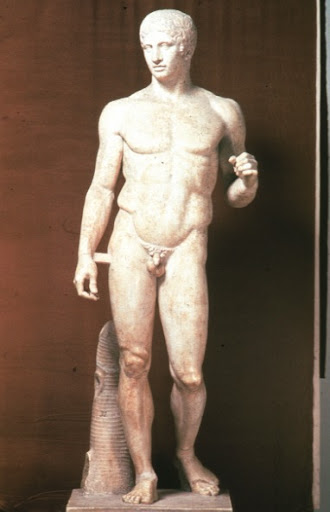Busts of Roman Republicans were uniformly literal reproductions of individual faces. Although their style derives from Hellenistic and Etruscan portraits, Republican portraits are one way the patrician class celebrated its elevated statues. The subjects were exclusively men and were accurate records of their distinctive features. The result was a statement about the man's personality: serious, experienced, determined- virtues that were much admired during the Republic.
The Early Empire rule of Augustus brought peace and prosperity to the war weary Mediterranean world. During this time the emperors commissioned a huge number of public works throughout the Empire. One of these such works was the Procession of the imperial family on the south frieze of the Ara Pacis Augustae. Augustus sought to present his new order as a golden age and emulated Classical models to make a political statement. The figures are recognizably contemporary figures, among which are portrayed children who look like children (not miniaturized adults) and who are acting like children. The decline in birthrate among Roman nobility so this and several other works were commissioned as a moral exemplar to further the emperor's own political and social agenda.
In the Hight Empire the supreme confidence is not conveyed in the statue portrait of Marcus Aurelius. This was the first portrait where a Roman emperor appeared weary, saddened, and even worried. The ruler's character, thoughts, and soul were exposed for all to see. This was a major turning point in the history of ancient art and marked the beginning of the end of classical art's domination in the Greco-Roman world.
During the Late Empire, on the Sarcophagi depicting the chaotic scene of battle between Romans and a northern foe, the increasing dissatisfaction of the classical style as portrayed by late Roman artists is exemplified. The writhing and highly emotive figures were spread across the entire relief with no illusion of space behind them. This piling of figures was an even more extreme rejection of classical perspective than using floating ground lines. The human figures aren't as realistic in form, but their animation and motion is more natural.
As an attempt to restore order to Roam in the Late Empire four individuals were chosen to rule together. This sculpture of the tetrarchs portrays four figures individual in appearance. This shows the loss of identity of the rulers as they are all equal. Each grasps a sheathed sword in the left hand and their right arms embrace one another in a gesture of concord. They have large cubical heads on squat bodies, schematic drapery, shapeless bodies, and emotionless masks of faces. The human figure one again is conceived in iconic terms. Idealism, naturalism, individuality, and personality now belong to the past.




